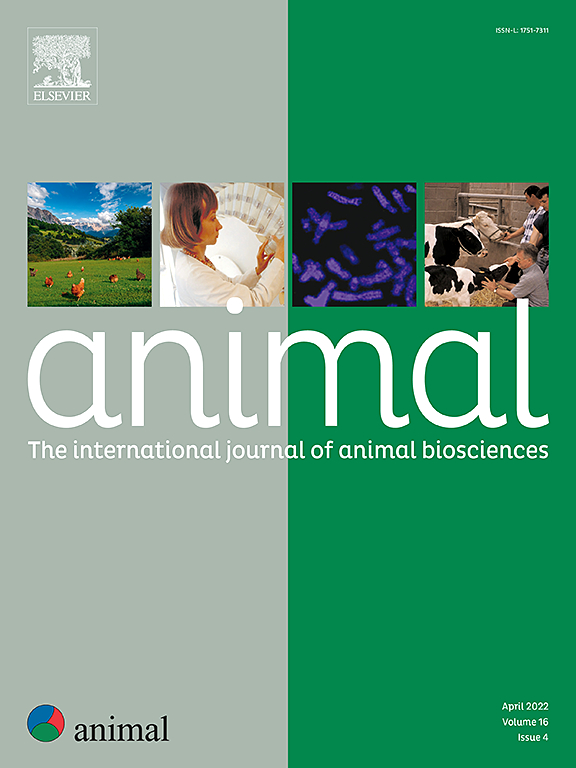Uncovering inbreeding patterns and adaptive genes in Tswana goats
IF 4.2
2区 农林科学
Q1 AGRICULTURE, DAIRY & ANIMAL SCIENCE
引用次数: 0
Abstract
The Tswana goat, a key component of Botswana’s livestock, is renowned for its resilience and adaptability to low-resource environments. The objective of this study was to use homozygosity (ROH) and supplementary methods (FST, iHS, xp-EHH, Rsb) to identify selection signatures and inbreeding pattern of the indigenous Tswana goat. A total of 216 goats were used, that is, Tswana (n = 114) from three agroecological regions in Botswana and Boer (n = 102), a reference population from South Africa. After quality control, 216 animals and 49 732 single−nucleotide polymorphisms were available for analysis. Tswana goats exhibited an average ROH length of 2.20 Mb and 85.71 ROH per goat, while Boer goats had longer, fewer ROH, averaging 155.96 Mb and 3.14 ROH per goat. Tswana goats had a lower inbreeding coefficient (FROH = 0.08) compared to Boer goats (FROH = 0.13). Significant ROH hotspots were found on chromosomes 12, 6, and 5 in Tswana goats and on chromosomes 24, 14, 9, 8, and 6 in Boer goats, with 27 annotated genes identified. Multiple selection signature detection methods detected genes such as PUS7L, ADAMTS20, TWF1, PRICKLE1 YAF2 and GXYLTI. Key genes associated with reproductive fitness (ATP12A, RNF17), immune response (IL17D, PARP4), coat colour variation (ADAMTS20), and milk synthesis (TWF1) were highlighted in Tswana goats, reflecting adaptive responses to environmental pressures. The study provides insights into the genetic adaptations and historical breeding of Tswana goat. This knowledge is crucial for implementing effective conservation strategies and enhancing the resilience of indigenous goat populations. By prioritising the genetic study of these goats, Botswana can ensure the sustainability of its unique livestock resources, promoting both food security and rural development in the region.
揭示茨瓦纳山羊的近亲繁殖模式和适应性基因
茨瓦纳山羊是博茨瓦纳牲畜的重要组成部分,因其对低资源环境的适应力和适应性而闻名。本研究的目的是利用纯合性(ROH)和FST、his、xp-EHH、Rsb等辅助方法对茨瓦纳山羊的选择特征和近交模式进行鉴定。总共使用了216只山羊,即来自博茨瓦纳三个农业生态区的茨瓦纳山羊(n = 114)和来自南非的参考种群波尔山羊(n = 102)。经质量控制,共有216只动物和49 732个单核苷酸多态性可供分析。茨瓦纳山羊的平均ROH长度为2.20 Mb,每只山羊的平均ROH长度为85.71,而布尔山羊的ROH长度更长,平均为155.96 Mb,每只山羊的平均ROH长度为3.14。茨瓦纳山羊的近交系数(FROH = 0.08)低于布尔山羊(FROH = 0.13)。在茨瓦纳山羊的第12、6和5号染色体以及波尔山羊的第24、14、9、8和6号染色体上发现了显著的ROH热点,共鉴定出27个注释基因。多重选择特征检测方法检测到PUS7L、ADAMTS20、TWF1、PRICKLE1、YAF2、GXYLTI等基因。在茨瓦纳山羊中,与生殖适应性(ATP12A、RNF17)、免疫反应(IL17D、PARP4)、毛色变异(ADAMTS20)和奶合成(TWF1)相关的关键基因被突出显示,反映了对环境压力的适应性反应。这项研究为茨瓦纳山羊的遗传适应和历史育种提供了见解。这些知识对于实施有效的保护战略和增强本地山羊种群的恢复能力至关重要。通过优先进行这些山羊的遗传研究,博茨瓦纳可以确保其独特的牲畜资源的可持续性,从而促进该地区的粮食安全和农村发展。
本文章由计算机程序翻译,如有差异,请以英文原文为准。
求助全文
约1分钟内获得全文
求助全文
来源期刊

Animal
农林科学-奶制品与动物科学
CiteScore
7.50
自引率
2.80%
发文量
246
审稿时长
3 months
期刊介绍:
Editorial board
animal attracts the best research in animal biology and animal systems from across the spectrum of the agricultural, biomedical, and environmental sciences. It is the central element in an exciting collaboration between the British Society of Animal Science (BSAS), Institut National de la Recherche Agronomique (INRA) and the European Federation of Animal Science (EAAP) and represents a merging of three scientific journals: Animal Science; Animal Research; Reproduction, Nutrition, Development. animal publishes original cutting-edge research, ''hot'' topics and horizon-scanning reviews on animal-related aspects of the life sciences at the molecular, cellular, organ, whole animal and production system levels. The main subject areas include: breeding and genetics; nutrition; physiology and functional biology of systems; behaviour, health and welfare; farming systems, environmental impact and climate change; product quality, human health and well-being. Animal models and papers dealing with the integration of research between these topics and their impact on the environment and people are particularly welcome.
 求助内容:
求助内容: 应助结果提醒方式:
应助结果提醒方式:


